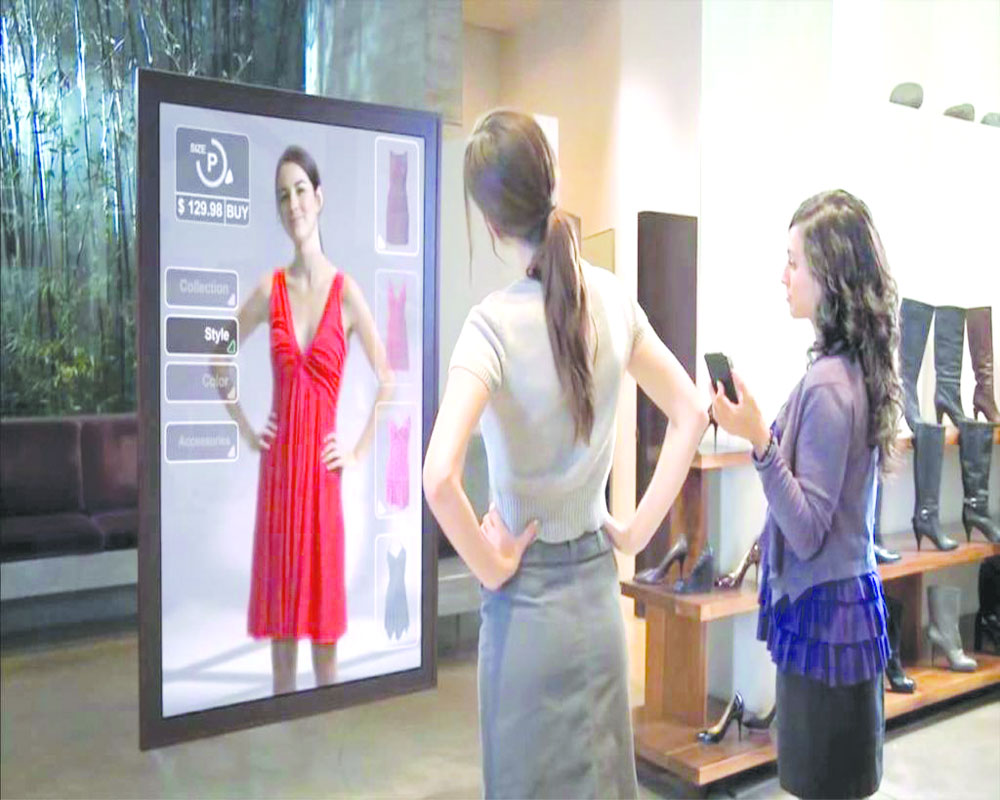As the pandemic hits the world, virtual fitting rooms, garment hygiene, integrated online and offline sales might be the norm forward, says Sakshi Sharma
Not too long back, stepping into a store, trying out several outfits and purchasing the one with the best fit and style was a routine. But that will not be the case anymore. In the Coronavirus-hit world, fashion companies have been forced to halt their operations as all the stores are shut and the supply chains are left hanging mid-way.
The major question here is — What will happen to the industry when the pandemic is over? Fashion designer Payal Jain says that the fashion world has been moving towards change for the last decade, as fashion weeks have been logistically and monetarily strained. This global shift will certainly bring change to the formats we have been used to and force us to rethink the entire model. A lot of the interaction that happens during fashion weeks can easily move online but sadly, the experience of watching a show cannot. Like everything else around us, we will need to be creative and build platforms that don’t endanger anyone’s life and health. Large gatherings will be a thing of the past and new platforms will evolve. Life and fashion after COVID-19 will certainly not be the same!
What next?
Right from consumer choices, pricing to upcycling and sustainability, the fashion industry might undergo massive changes. It may, at the same time, give rise to new themes and trends as cash flow is less. Ayushi Gudwani, founder and CEO, FableStreet, says, “No matter what, the industry is here to stay undoubtedly. However, the consciousness of the customer, both about the costing and the products, is going to evolve. There will be new trends. The functionality of the garment will take precedence over style. Things like anti-microbial, multiple-use wear or easy to wash and quick-dry would become much more important over stylish garments. You would want to ensure that your outfits are regularly sanitised.” She goes on to add that the boundaries between office wear and evening wear would start blurring as people would want to use multi-purpose garments from morning to evening. They wouldn’t want to buy 10 outfits but prefer one. This mindset is here to stay.
In terms of pricing, the focus will be more on value for money products so high and luxury fashion might take a back seat. Ayushi agrees and says, “Yes, this is because the consumers are becoming fairly conscious about where to spend. We will go through a difficult time for more than one-and-a-half years. And likely to go through recession and job losses too. So people would like to save money, especially in men’s fashion. Overall, the mindset of conserving cash and focussing on value will prevail.”
While the pandemic has put brakes on the fashion industry, Sana Jhamb, director, PR and business development, Epistle Communications, believes that this is short-term and expects a gradual pick up. Focus on upcycling and sustainability will become a norm instead of just being a short-term trend. “The industry is likely to develop more transparent, sustainable, localised, and self-sufficient supply chains,” adds she.
While agreeing with Ayushi over drop in purchase of fast fashion and a shift towards comfort and sustainability, there are a few emerging trends which Sarika Grover, co-founder, Green Giraffes Consulting, shares. “An inclination towards athleisure brands is being predicted as most of the people would want to be active at home. Athleisure was already a growing trend and category and is now expected to do better than any other segment in the sector.” She adds that we will also see smaller collections and less number of Stock Keeping Units (SKUs) per season for a few years as expenditure on clothing will reduce.
Will trials and stores be the same again?
Nothing can quite replicate the experience of trying out clothes for the perfect fit and flattering silhouettes before buying. That was the reason brands like Myntra started the “Try and Buy” offer to cut through customer apprehension about how a particular garment would look. As a result, online fashion was increasingly becoming comfortable for customers to shop but this too, along with offline stores, will suffer setbacks. In a situation, where maintaining distance is the main solution, how can one ensure that the outfit one is trying out is safe?
Payal says that new and creative ways of accessing sizes and deciding fits will probably evolve so that people feel more comfortable buying online or at retail outlets without being apprehensive. Designer Purvi Doshi feels that the fashion business will gradually evolve as an online business as people will start preferring it more. However, contrary to this belief, Ayushi makes an important point. “People assume that trial will become riskier in a retail setup. However, they miss that in an online setup, returned products are re-sent. This will become risky because one will not have control over these garments as to how many people wore it and if that is safe,” she says.
She goes on to add that trials are important but these will reduce in due course of time. The consumer will become smarter. For example, if the style of a particular brand fits you well, you would just want to pick up a fresh piece rather than trying it out. From the brand perspective, she says, that they will have to be extremely conscious to ensure that the outfits are safe and sanitised. “We can reduce the overall trial to 40-50 pieces and the remaining will be kept fresh. Then those tried pieces will have to be sent back to the manufacturing unit to be sanitised. Meanwhile, the fresh stock can be used for trials,” adds she.
Focus and trust on the brand you’re purchasing from will become very important. She also raises her concern about the unorganised market as it will become risky and organised players and trustworthy brands will take precedence.
Well, fashion stores will never be the same again for one more reason — we will now be more cautious of gatherings. People will be really conscious and would want to maintain social distancing. “Stores will need to put a lot of safeguards in place. For instance, not allowing entry of more than a particular number of visitors at a particular time. Ensuring that people maintain a reasonable distance from each other. We are also coming up with ideas such as creating a “by appointment only” section where the access will be given to only a limited number of people during a given time period,” says Ayushi.
Maintaining hygiene in the stores is must. The pandemic has made people hyper-aware of these issues and hygiene standards will have to increase. “The clothes should be steam-ironed and sanitised. The trial rooms will have to be equipped with face mask, sanitisers and hand gloves,” says Purvi.
Sana expects a slow pick-up in brick-and-mortar shops. Online sales are likely to increase while physical retail will see a return to normalcy only after a safe time has passed.
Agreeing with Purvi, Grover adds, “AI Virtual trial rooms would become important. There are a few companies who have built these softwares. I can walk into a store and based on my measurements and other attributes, shortlist garments. So this will help me to buy garments based on the virtual fitting or at the very least, try a lesser number of garments.”
Can rentals trend now?
Rental fashion market will become very risky as people will be hesitant to rent clothes. They won’t be sure about the number of people who have worn or rented a certain dress before them. Naturally, this would make them apprehensive about safety. The market will have to ramp up its hygiene standards to assure customers that they are safe. “People’s hesitation is likely to drive down sales, initially, but as new processes and systems are put into place, a new normal will emerge,” says Grover.
Earlier, price was an important factor for the success of rental companies. Going forward, now it would be a combination of price and hygiene. “Communication around care and hygiene would drive the business. Packaging would need to be re-looked. Conversations have already begun on materials and how long the virus can stay on a cardboard box,” adds she. Ayushi adds, “The price value equation will undergo changes. Consumers would not be ready to pay more and want that the rentals are sanitised in the same cost.”
Another trend that may see an upward spiral is that people would be comfortable with repeating the outfits and upcycling existing ones rather than renting. Ayushi says, “People would prefer buying one quality garment.”
Sana holds out a sliver of hope, “Once the threat is over, we will fall back into the same routine, perhaps with some added precautions.”


























